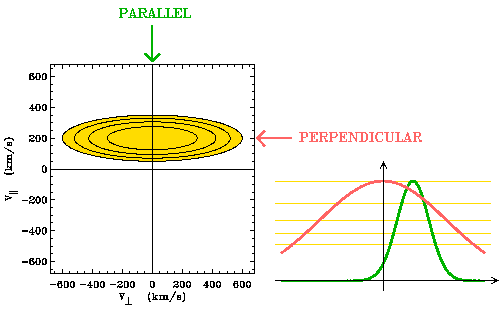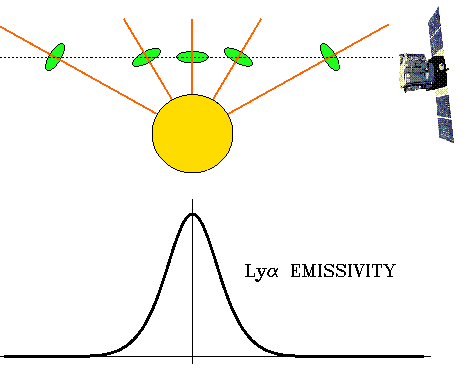

Once data from the UVCS instrument has been calibrated and corrected to remove non-coronal components, the UV line profiles and visible-light pB (polarization brightness) values can be compared with the results of theoretical radiative-transfer calculations.
On this page (see below) we provide a Fortran code, CUES, which computes the radiative transfer of UV spectral lines and white-light pB, and outputs predicted intensities and profiles for given input parameters. CUES stands for Coronal Ultraviolet Emission Synthesis. Full documentation and sample input/output files are included with the code.
 Brief Overview:
Brief Overview:The input parameters to the CUES code specify, among other things, the velocity distribution function of the atoms or ions which produce the radiation. Specifically, we use the simplest type of distribution function which retains most of the observed features of the solar corona - namely an anisotropic ``bi-Maxwellian'' distribution. The following contour plot shows a representative bi-Maxwellian distribution:

(Above, the levels of the yellow contour-regions on the left are also plotted in the line-plots on the right, along with ``cuts'' across the distribution in two directions.)
Four parameters specify this distribution function:
 The number density of particles
(e.g., the integral over the distribution in velocity space).
The number density of particles
(e.g., the integral over the distribution in velocity space).
 The bulk outflow velocity, taken to be
parallel to the magnetic field lines.
The bulk outflow velocity, taken to be
parallel to the magnetic field lines.
 The unresolved most-probable (``microscopic'') speed
in the direction parallel to the magnetic field.
If this were a true Maxwellian, this would be the thermal speed,
related to the temperature.
The unresolved most-probable (``microscopic'') speed
in the direction parallel to the magnetic field.
If this were a true Maxwellian, this would be the thermal speed,
related to the temperature.
 The unresolved most-probable speed
in the direction perpendicular to the magnetic field
(possibly containing the rms fluctuations due to
Alfven waves).
In a true Maxwellian distribution, the velocity-components in the parallel
and perpendicular directions are equal.
The unresolved most-probable speed
in the direction perpendicular to the magnetic field
(possibly containing the rms fluctuations due to
Alfven waves).
In a true Maxwellian distribution, the velocity-components in the parallel
and perpendicular directions are equal.
In the CUES code, the user can specify all four of these parameters in the coronal model, but only within a basic (pre-determined) geometry. The code presently models the corona as a spherically-symmetric system, with ``hard-coded'' radial functions for the density and outflow velocity which the user can only modify by constant multipliers. The microscopic speeds are modeled as constants for any given model observation. More complicated solar wind models (e.g., those with non-radially divergent field-lines) can be programmed by the user by delving into the code. Once this is done, however, the responsibility for verifying the accuracy of the output is firmly in the hands of the user.
Because the solar corona is optically-thin in ultraviolet light, the line profiles we see are integrated over the entire line-of-sight in the wind. The following shows this schematically for a spherically-symmetric model corona. The green ellipses show the local geometry of a bi-Maxwellian distribution with a larger microscopic speed in the perpendicular direction than in the parallel direction.

Above we plot a representative emissivity for the line-center of the H I Lyman alpha emission line, on the same horizontal spatial scale as the image above it. Effectively, this is a relative ``contribution function'' which shows which portions of the line-of-sight contribute to the intensity integral. Note that it does not extend extremely far away from the sun (mainly because the density decreases rapidly with radius), but it is not so sharply-peaked that the emissivity at the 90-degree scattering point (i.e., the plane of the sky) totally dominates. The CUES code performs this integration numerically; see the documentation for more details.
The process of varying the input parameters to find a valid model of the observed corona is not simple or straightforward. Unfortunately, in many cases there are more variables than constraints from the observational data. Many of the issues to be confronted are described in the documentation, below. The primary purpose of presenting the CUES code to the community is to provide a handy starting point so that users need not re-derive the reasonably well-understood radiative transfer equations needed to compute the line profiles and intensities. For research issues beyond the basic models in the code, we encourage users to enter into collaborations with the scientists already involved in UVCS operations and data analysis.
 Files to Download:
Files to Download:Documentation (postscript file, 1365 K) for the code and its input parameters. This document was originally written for undergraduate students working with the UVCS/SOHO group, so we hope its introductory level of presentation will be helpful to those unfamiliar with UV spectral diagnostics.
Complete software package (UNIX-compressed tar file, 222 K) with Fortran source code, documentation, and sample input/output files.
If you do not have access to a UNIX or compatible system to deal with these files, please contact Steven Cranmer.
 GO BACK to the
UVCS/SOHO
Home Page.
GO BACK to the
UVCS/SOHO
Home Page.
This WWW page was developed by Steven Cranmer